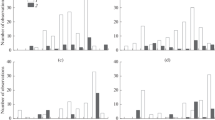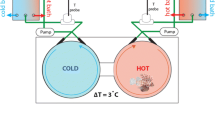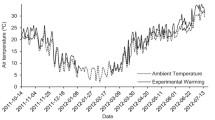Summary
The effect of photoperiod on the upper thermal tolerance of two species of frogs was studied by using the critical thermal maximum (CTM) as the end point. Both species are heliotropic and from temperate climates, but Hyla labialis lives under a near constant tropical photoperiod while Rana pipiens lives under a varying temperatezone photoperiod. The CTM of both species was studied over a 24-hour period to determine if a rhythm of temperature tolerance exists. In all but one of the acclimatization conditions used, the CTM of R. pipiens was higher than that of H. labialis. This agrees with what is known of their thermal ecology. Photoperiod significantly affects the CTM of both species. For Rana pipiens long (LD 16:8) photoperiods result in significantly higher thermal tolerance than short (LD 8:16) or moderate (LD 12:12) photoperiods at both 15 and 25° C. H. labialis shows a different pattern, having highest CTM at 25°C, LD 12:12 and lowest at 15°C, LD 12:12. When acclimated to a short (LD 8:16) photoperiod certain aspects of the frogs' tolerance of high temperatures are altered. At the same acclimatization the CTM of R. pipiens is higher than that of H. labialis, except under a combination short light regime and low temperature, and H. labialis at LD 8:16 shows no thermal acclimation between 15 and 25°C. Significant variation in the CTM over a 24-hour period occurred in H. labialis acclimatized at 25°C, LD 12:12 and R. pipiens at 25°C, LD 8:16 and 15°C, LD 12:12. For both species the 24-hour rhythm of temperature tolerance, when it occurs at LD 12:12, might be of adaptive value. Times of highest thermal tolerance are in the late morning or early afternoon and lowest tolerance is during the dark period. For R. pipiens under the unnatural combination of 25°C, LD 8:16, the pattern is reversed. When all three significant cycles are phase shifted so that the times of highest tolerance coincide, the pattern of the curves is very similar.
Similar content being viewed by others
References
Arbelaez, E. P.: Los recursos naturales del clima en Colombia. Recursos Naturales de Colombia 1 (3), 164–167 (1954).
Brattstrom, B. H.: Thermoregulation in tropical amphibians. Yearbook Amer. Phil. Soc. 284–287 (1960).
— A preliminary review of the thermal requirements of amphibians. Ecology 44 (2), 238–254 (1963).
— Thermal acclimation in anuran amphibians as a function of altitude and latitude. Comp. Biochem. Physiol. 24 (1), 93–111 (1968).
—, and P. Lawrence: The rate of thermal acclimation in anuran amphibia. Physiol. Zool. 35 (2), 148–156 (1962).
Brett, J. R.: Some principles in the thermal requirements of fishes. Quart. Rev. Biol. 31, (2), 75–87 (1956).
Bünning, E.: Biological clocks. Cold Spr. Harb. Symp. quant. Biol. 25, 1–9 (1960).
Carlson, A., and F. Serin: The toxicity of Nikethamide at different times of the day. Acta pharmacol. (Kbh.) 6, 187–193 (1950).
Cowles, R. B., and C. M. Bogert: A preliminary study of the thermal requirements of desert reptiles. Bull. Am. Museum of Nat. Hist. 8, 256–296 (1944).
Duncan, O. B.: Multiple range and multiple F tests. Biometrics 11 (1), 1–42 (1955).
Dunn, E. R.: Herpetology of the Bogotá area. Rev. Acad. Colombiana Ci. Exact. Fist. Nat. 6 (21), 68–81 (1944).
Ertel, R. J., F. Ungar, and F. Halberg: Circadian rhythm in susceptibility of mice to toxic doses of Su-4885. Fed. Proc. 22, 211 (1963).
Fitch, H. S.: Temperature responses in free-living amphibians and reptiles of northeastern Kansas. Univ. Kansas Pub. 8, 417–476 (1956).
Fry, F. E., J. R. Brett, and G. H. Clawson: Lethal limits for young goldfish. Rev. canad. Biol. 1, 50–56 (1942).
Halberg, F., J. J. Bittner, R. J. Gully, P. G. Albrecht, and E. L. Brackney: 24-hour periodicity and audiogenic convulsions in I mice of various ages. Proc. Soc. exp. Biol. (N.Y.) 88, 169–173 (1955).
—, and A. N. Stephens: 24-hour periodicity in mortality of C mice from E. coli lipopolysaccharide. Fed. Proc. 17, 439 (1958).
Harker, J. E.: The Physiology of Diurnal Rhythms. 114 p. London: Cambridge Univ. Press 1964.
Heatwole, H., N. Mercado, and E. Oritz: Comparison of CTM of two species of Puerto Rican frogs of the genus Eleuthrodactylus. Physiol. Zool. 38, (1), 1–8 (1965).
Hoar, W. S.: Seasonal variation in the resistance of goldfish to temperature. Trans. roy. Soc. Can. 49, 25–34 (1955).
— Photoperiodism and thermal resistance of goldfish. Nature (Lond.) 178, 364–365 (1955).
—, and G. Beth Robertson: Temperature resistance of goldfish maintained under controlled photoperiods. Can. J. Zool. 37, 419–428 (1959).
Hubbs, C. L., and C. Hubbs: An improved graphical analysis and comparison of series of samples. Syst. Zool. 2 (1), 49–57 (1953).
Hutchison, V. H.: Critical thermal maxima in salamanders. Physiol. Zool. 34, (2), 92–125 (1961).
—, and R. J. Kosh: The effect of photoperiod on the critical thermal maxima of painted turtles (Chrysemys picta). Herpetologica 20, (4), 233–238 (1964).
—, A. Vinegar, and R. J. Kosh: Critical thermal maxima in turtles. Herpetologica 22, (1), 32–41 (1966).
Kosh, R. J., and V. H. Hutchison: Daily rhythmicity of temperature tolerance in the eastern painted turtle, Chrysemys picta picta. Copeia 1968 (2), 244–246.
Larson, M. W.: The critical thermal maxima of the lizard Sceloporous occidentalis occidentalis Baird and Girard. Herpetologica 17, 113–122 (1961).
Marte, E., and F. Halberg: Circadian susceptibility in mice to librium. Fed. Proc. 20, 305 (1961).
McLeese, D. W.: Effects of temperature, salinity and oxygen on the survival of the American lobster. J. Fish. Res. Bd. Can. 13, 247–272 (1956).
Orr, P. R.: Heat death, II. Differential response of entire animal (Rana pipiens) and several organ systems. Physiol. Zool. 29, (4), 294–302 (1955).
Pittendrigh, C. S., and V. C. Bruoe: Daily rhythms as coupled oscillator systems and their relation to thermoperiodism, p. 475–505. In: R. B. Withrow (ed.), Photoperiodism and Related Phenomena in Plants and Animals. Amer. Ass. Advan. Sci. Publ. 55 (1959).
Roberts, J. L.: The influence of photoperiod upon thermal acclimation by the crucian carp Carassius carassius. 1. Verh. Dsch. Zool. Ges. 1960, S. 73–78.
Smithsonian Institute: Smithsonian Meterological Tables. Smithson. misc. Coll. 114, 506–559 (1951).
Sollberger A.: Biological Rhythm Research 461 p. New York: Elsevier Publ. C 1965.
Stebbins, R. C., and J. R. Hendrickson: Field studies of amphibians in Colombia, South America. Univ. Calif. Publ. Zool. 56, (5), 497–540 (1959).
U. S. Army: U. S. Army Area Handbook for Colombia. Washington, D. C.: U. S. Gov. Printing Office 1961.
U. S. Department of Commerce: Climatological data: New Engl. 77 (13), 322 (1966).
Zwelfel, R. G.: Studies of the critical thermal maxima of salamanders. Ecology 38 (1), 64–69 (1957).
Author information
Authors and Affiliations
Rights and permissions
About this article
Cite this article
Mahoney, J.J., Hutchison, V.H. Photoperiod acclimation and 24-hour variations in the critical thermal maxima of a tropical and a temperate frog. Oecologia 2, 143–161 (1969). https://doi.org/10.1007/BF00379157
Received:
Issue Date:
DOI: https://doi.org/10.1007/BF00379157




